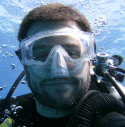Horoirangi Marine Reserve |
January 1, 2020 |
First dive of the new year and first dive of the new decade. We were on vacation in Nelson for the week and I contacted Abyss Dive to see if they had any dives planned. The only day that really worked for me that week was 1 January, 2020 and they were very gracious and accommodating even though I was the only person up for a dive on New Year's Day!
The first dive was in the Horoirangi Marine Reserve. According to the New Zealand Department of Conservation,
The bluffs overlooking Horoirangi Marine Reserve are more than a dramatic landscape, they are also the source of rocks for the rugged boulder reefs below. The reefs extend offshore up to 400 m and to a depth of around 20 m.
The boulders on the upper shore, regularly moved by the waves, are mostly devoid of life. Lower down the reefs are much more stable, forming a matrix of interlocking boulders interspersed with occasional patches of bedrock.
The reefs support a typical array of animals. Shellfish, anemones, sponges and sea squirts cling to the rocks; snails, starfish and crustaceans move secretively amongst the boulders, and various fish patrol above.

It's impossible to see from the picture but there are also wild goats dotting the bluff, which is much steeper than it appears to be.
The owner/operator/captain/dive master Paul had brought all of the rental gear onto the boat already. Gearing up in rental equipment can be a pain sometimes but getting in the water always makes it all worth it.





The Department of Conservation nailed it in saying "The reefs support a typical array of animals." It was home to a number of New Zealand's usual suspects.

Crab
To get the picture of that crab, I had to stop for a minute or two. When I looked up after taking the picture, I discovered the dive master (naturally) had moved on. No worries.
I let my dive training kick in and started the lost buddy procedure. I stayed where I was and looked around for 1-2 minutes in the hopes of spotting Paul. No luck so I slowly ascended to the surface to begin a surface search.
Of course at 5 metres below the surface, I had to do a safety stop. Before I even got to minute one of my safety stop, Paul managed to find me there even though the visibility was poor (only 1 metre in places). We descended and continued the dive. All good!

Blue Cod

Crayfish
The crayfish were among the largest I've ever seen in NZ. The dive master estimated there were crays tipping the scales at 4-5 kilograms. Seeing them literally had me hungry for crayfish so for the next dive we left the reserve and went in search of crays we could catch.
Horoirangi Marine Reserve
| Location: Cable Bay, New Zealand |
Statistics
|
|
|
Comments
blog comments powered by Disqus

